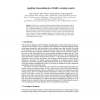Free Online Productivity Tools
i2Speak
i2Symbol
i2OCR
iTex2Img
iWeb2Print
iWeb2Shot
i2Type
iPdf2Split
iPdf2Merge
i2Bopomofo
i2Arabic
i2Style
i2Image
i2PDF
iLatex2Rtf
Sci2ools
ECTEL
2007
Springer
2007
Springer
Applying Sensemaking in a Mobile Learning Scenario
In this work, a new type of collaborative learning activity is proposed in order to enable students to explore and understand information in highly mobile situations. We call this “mobile sensemaking” and is based on people engaged in multiple parallel, rapid and ad-hoc interactions, rather than structured decision processes. This activity takes place in a traditional classroom context, thus proposing a new way to design more participative and active “lectures”. Mobile sensemaking proposes a proximity model and uses mobile computing devices in order to carry on collaborative activities according to the domain context and physical proximity.
| Added | 07 Jun 2010 |
| Updated | 07 Jun 2010 |
| Type | Conference |
| Year | 2007 |
| Where | ECTEL |
| Authors | Gustavo Zurita, Nelson Baloian, Pedro Antunes, Felipe Baytelman |
Comments (0)

